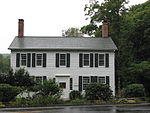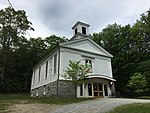Thomas Shepard House
Houses on the National Register of Historic Places in Berkshire County, MassachusettsNew Marlborough, Massachusetts

The Thomas Shepard House is a historic house at 764 East Hill Road in New Marlborough, Massachusetts, United States. It is one of the older homes in New Marlborough (built 1798), and is one of three 18th century houses on a 3-mile (4.8 km) stretch of East Hill Road, which was then one of only three roads in the town. Thomas Shepard, for whom it was built, was a major figure in the town's early history. The house was listed on the National Register of Historic Places in 1984.
Excerpt from the Wikipedia article Thomas Shepard House (License: CC BY-SA 3.0, Authors, Images).Thomas Shepard House
East Hill Road,
Geographical coordinates (GPS) Address Nearby Places Show on map
Geographical coordinates (GPS)
| Latitude | Longitude |
|---|---|
| N 42.089166666667 ° | E -73.200555555556 ° |
Address
East Hill Road 807
01259
Massachusetts, United States
Open on Google Maps










